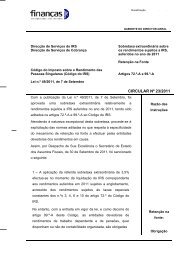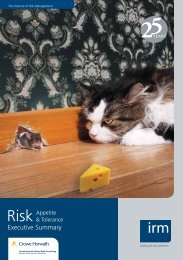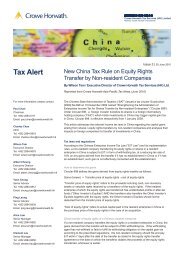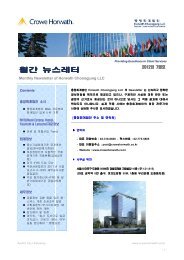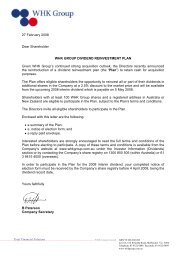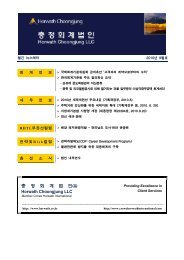Guidance Paper - The Institute of Risk Management
Guidance Paper - The Institute of Risk Management
Guidance Paper - The Institute of Risk Management
You also want an ePaper? Increase the reach of your titles
YUMPU automatically turns print PDFs into web optimized ePapers that Google loves.
Questions for the boardroom<br />
Below we set out some questions that we think boards may want to consider, as part<br />
<strong>of</strong> an iterative process over time, as they develop their approaches to risk appetite and<br />
which will enable them to remain at the forefront <strong>of</strong> the discussion. One clear outcome<br />
from our consultation exercise was that, despite the expected variation in views on the<br />
technical aspects <strong>of</strong> risk appetite, there was a common acceptance <strong>of</strong> these questions as<br />
a useful starting point for board discussion.<br />
Background<br />
1. What are the significant risks the<br />
board is willing to take What are the<br />
significant risks the board is not willing<br />
to take<br />
2. What are the strategic objectives <strong>of</strong><br />
the organisation Are they clear What<br />
is explicit and what is implicit in those<br />
objectives<br />
3. Is the board clear about the nature<br />
and extent <strong>of</strong> the significant risks it is<br />
willing to take in achieving its strategic<br />
objectives<br />
4. Does the board need to establish<br />
clearer governance over the risk<br />
appetite and tolerance <strong>of</strong> the<br />
organisation<br />
5. What steps has the board taken to<br />
ensure oversight over the management<br />
<strong>of</strong> the risks<br />
Designing a risk appetite<br />
6. Has the board and management<br />
team reviewed the capabilities <strong>of</strong> the<br />
organisation to manage the risks that<br />
it faces<br />
7. What are the main features <strong>of</strong> the<br />
organisation’s risk culture in terms<br />
<strong>of</strong> tone at the top Governance<br />
Competency Decision making<br />
8. Does an understanding <strong>of</strong> risk<br />
permeate the organisation and its<br />
culture<br />
9. Is management incentivised for good<br />
risk management<br />
10. How much does the organisation<br />
spend on risk management each year<br />
How much does it need to spend<br />
11. How mature is risk management in the<br />
organisation Is the view consistent at<br />
differing levels <strong>of</strong> the organisation Is<br />
the answer to these questions based<br />
on evidence or speculation<br />
Constructing a risk appetite<br />
12. Does the organisation understand<br />
clearly why and how it engages with<br />
risks<br />
13. Is the organisation addressing all<br />
relevant risks or only those that can<br />
be captured in risk management<br />
processes<br />
14. Does the organisation have a<br />
framework for responding to risks<br />
Implementing a risk appetite<br />
15. Who are the key external stakeholders<br />
and have sufficient soundings been<br />
taken <strong>of</strong> their views Are those views<br />
dealt with appropriately in the final<br />
documentation<br />
16. Has the organisation followed a<br />
robust approach to developing its risk<br />
appetite<br />
17. Did the risk appetite undergo<br />
appropriate approval processes,<br />
including at the board (or risk<br />
oversight committee)<br />
18. Is the risk appetite tailored and<br />
proportionate to the organisation<br />
19. What is the evidence that the<br />
organisation has implemented the risk<br />
appetite effectively<br />
Hungry for risk<br />
Governing a risk appetite<br />
20. Is the board satisfied with the<br />
arrangements for data governance<br />
pertaining to risk management data<br />
and information<br />
21. Has the board played an active<br />
part in the approval, measurement,<br />
monitoring and learning from the risk<br />
appetite process<br />
22. Does the board have, or does it need,<br />
a risk committee to, inter alia, oversee<br />
the development and monitoring <strong>of</strong><br />
the risk appetite framework<br />
<strong>The</strong> journey is not over - final<br />
thoughts<br />
23. What needs to change for next time<br />
round<br />
24. Does the organisation have sufficient<br />
and appropriate resources and<br />
systems<br />
25. What difference did the process make<br />
and how would we like it to have an<br />
impact next time round<br />
<strong>The</strong> word “appetite” brings connotations <strong>of</strong> food, hunger and satisfying one’s<br />
needs. We think that this metaphor is not always helpful in understanding the<br />
phrase “risk appetite”. When those two words appear together we think it is<br />
more appropriate to think in terms <strong>of</strong> ‘fight or flight’ responses to perceived risks.<br />
Most animals, including human beings, have a ‘fight or flight’ response to risk. In<br />
humans this can be over-ruled by our cognitive processes. Our interpretation <strong>of</strong><br />
risk appetite is that it represents a corporate version <strong>of</strong> exactly the same instincts<br />
and cognitive processes. However, since these instincts are not ”hardwired“ in our<br />
corporate “nervous and sensory” systems we use risk management as a surrogate.<br />
10






